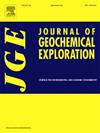柴达木盆地西部七格泉地区新近系十子沟组碎屑锆石地球化学特征及UPb年代学:构造、古气候和铀源意义
IF 3.3
2区 地球科学
Q1 GEOCHEMISTRY & GEOPHYSICS
引用次数: 0
摘要
柴达木盆地新生代地层与阿尔金-塔格造山带的过渡带上,祁克泉矿区最近发现了铀矿床。本文对该区新生代狮子沟组砂岩进行了详细的岩石地球化学和UPb碎屑锆石年代学分析。本研究旨在厘清物源,探讨地层、构造、古气候、油气与砂岩型铀矿床成因之间的相互关系。碎屑锆石年龄聚集在343 ~ 542和200 ~ 285 Ma两个时期,与阿尔金山带和东昆仑造山带的岩石单元相对应。锆石年龄谱对比分析显示,阿尔金塔格山和齐曼塔格山是主要的烃源区,阿尔金塔格山的锆石年龄最为显著。主要元素、微量元素和稀土元素分析表明,下狮子沟组沉积时期的构造条件相对稳定,沉积环境为氧化性,还原介质浓度较高。源区化学风化作用弱,再加上碎屑锆石颗粒呈棱角状,表明在干旱气候条件下,地壳迅速抬升,导致未风化碎屑物质快速搬运和沉积。含氧地表水将铀从侵蚀区输送到下狮子沟组的构造空洞中,并将其沉积在富氧沉积层中。随后,上升的富烃、富盐水流体沿构造裂缝侵入,将地层中的铀浸出,为铀矿化创造了有利的还原环境。新生代印度板块和欧亚板块的俯冲和碰撞引发了阿尔金高原的快速隆起,推动了气候变化,为铀矿形成提供了必要的氧化还原条件。这些发现为砂岩型铀矿床的沉积过程、构造演化和勘探提供了有价值的见解。本文章由计算机程序翻译,如有差异,请以英文原文为准。
Geochemical characteristics and UPb chronology of detrital zircon in the Neogene Shizigou Formation, Qigequan area, western Qaidam Basin: Implications for tectonics, paleoclimate, and uranium sources
Uranium deposits have been recently discovered in the Qigequan mining area, located at the transition zone between the Cenozoic strata of the Qaidam Basin and Altyn Tagh orogenic belt. This study presents detailed petrogeochemical and U![]() Pb detrital zircon geochronological analyses of sandstones from the Cenozoic Shizigou Formation within this region. This study aims to clarify the provenance and explore the interrelations among stratigraphy, tectonics, paleoclimate, hydrocarbons, and the genesis of sandstone-type uranium deposits. Detrital zircon ages are clustered in two periods: 343–542 and 200–285 Ma, corresponding with rock units in the Altyn Tagh and East Kunlun orogenic belts. Comparative analysis of zircon age spectra reveals the Altyn Tagh and Qimantag mountains as the primary source areas, with the Altyn Tagh being the most significant. Major, trace, and rare earth element analyses suggest relatively stable tectonic conditions and an oxidizing sedimentary environment during the deposition of the Lower Shizigou Formation, with a high concentration of reducing media. Low chemical weathering in the source region, coupled with the angularity of detrital zircon grains, indicates rapid uplift under arid climatic conditions, leading to the swift transport and deposition of unweathered clastic material. Oxygenated surface waters transported uranium from erosion areas into the structural cavities of the Lower Shizigou Formation, depositing it in oxygen-rich sedimentary layers. Subsequently, ascending hydrocarbon and brine-rich fluids intruded along structural fractures, leaching uranium from the strata and creating a favorable reducing environment for uranium mineralization. The Cenozoic subduction and collision of the Indian and Eurasian plates triggered the rapid uplift of the Altyn Tagh, driving climatic changes that generated the necessary redox conditions for uranium ore formation. These findings provide valuable insights into the sedimentary processes, tectonic evolution, and exploration of sandstone-type uranium deposits.
Pb detrital zircon geochronological analyses of sandstones from the Cenozoic Shizigou Formation within this region. This study aims to clarify the provenance and explore the interrelations among stratigraphy, tectonics, paleoclimate, hydrocarbons, and the genesis of sandstone-type uranium deposits. Detrital zircon ages are clustered in two periods: 343–542 and 200–285 Ma, corresponding with rock units in the Altyn Tagh and East Kunlun orogenic belts. Comparative analysis of zircon age spectra reveals the Altyn Tagh and Qimantag mountains as the primary source areas, with the Altyn Tagh being the most significant. Major, trace, and rare earth element analyses suggest relatively stable tectonic conditions and an oxidizing sedimentary environment during the deposition of the Lower Shizigou Formation, with a high concentration of reducing media. Low chemical weathering in the source region, coupled with the angularity of detrital zircon grains, indicates rapid uplift under arid climatic conditions, leading to the swift transport and deposition of unweathered clastic material. Oxygenated surface waters transported uranium from erosion areas into the structural cavities of the Lower Shizigou Formation, depositing it in oxygen-rich sedimentary layers. Subsequently, ascending hydrocarbon and brine-rich fluids intruded along structural fractures, leaching uranium from the strata and creating a favorable reducing environment for uranium mineralization. The Cenozoic subduction and collision of the Indian and Eurasian plates triggered the rapid uplift of the Altyn Tagh, driving climatic changes that generated the necessary redox conditions for uranium ore formation. These findings provide valuable insights into the sedimentary processes, tectonic evolution, and exploration of sandstone-type uranium deposits.
求助全文
通过发布文献求助,成功后即可免费获取论文全文。
去求助
来源期刊

Journal of Geochemical Exploration
地学-地球化学与地球物理
CiteScore
7.40
自引率
7.70%
发文量
148
审稿时长
8.1 months
期刊介绍:
Journal of Geochemical Exploration is mostly dedicated to publication of original studies in exploration and environmental geochemistry and related topics.
Contributions considered of prevalent interest for the journal include researches based on the application of innovative methods to:
define the genesis and the evolution of mineral deposits including transfer of elements in large-scale mineralized areas.
analyze complex systems at the boundaries between bio-geochemistry, metal transport and mineral accumulation.
evaluate effects of historical mining activities on the surface environment.
trace pollutant sources and define their fate and transport models in the near-surface and surface environments involving solid, fluid and aerial matrices.
assess and quantify natural and technogenic radioactivity in the environment.
determine geochemical anomalies and set baseline reference values using compositional data analysis, multivariate statistics and geo-spatial analysis.
assess the impacts of anthropogenic contamination on ecosystems and human health at local and regional scale to prioritize and classify risks through deterministic and stochastic approaches.
Papers dedicated to the presentation of newly developed methods in analytical geochemistry to be applied in the field or in laboratory are also within the topics of interest for the journal.
 求助内容:
求助内容: 应助结果提醒方式:
应助结果提醒方式:


